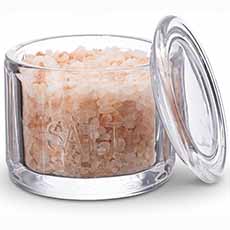|

[1] The only salted butter we buy (photo © Vermont Creamery).

[2] A modern salt cellar. Today you can find them in wood as well. Older styles were ceramic, crystal or glass. You can find it and other styles on Amazon and elsewhere (photo © KooK | Amazon).
|
|
Some people prefer salted butter, others prefer unsalted butter. Can you use them interchangeably in baking and cooking?
Use unsalted butter for baked goods such as cake, cookies, pastry and pie crusts, and salted butter for general cooking.
If you are using salted butter in a recipe that specifically calls for unsalted butter plus additional salt, simply omit 1/4 teaspoon of salt per 1/2 cup of butter.
The salt in salted butter acts as a preservative, allowing for a slightly longer shelf life; but that’s not a concern with modern refrigeration.
We prefer to keep just one type of butter—unsalted—adding salt to recipes as needed.
We keep a salt cellar (see below) of coarse-grained sea salt at the table.
Those who want to salt their butter can add a pinch—which also adds a delightful crunch.
MORE ABOUT BUTTER
Our favorite salted butter—the best we’ve ever had—is from Vermont Butter & Cheese Creamery. Made in the style of the finest European butters (higher in butterfat than standard U.S. butters), it has a salt content significantly lower than typical salted. The “less is more” approach produces a spectacular salted butter.
How many types of butter are there? See our Butter Glossary.
Check out the history of butter.
THE HISTORY OF THE SALT CELLAR
Since ancient times, people kept a small container of salt on the table, so people could add more salt if desired. Today we call them salt cellars (photo #2).
|
The term salt-cellar appears in English in the 15th century. It combines the English word salt with the Anglo-Norman word saler, which meant “salt container.”
Salt cellar, name most often used today, were known by a number of different names, names including master salt, open salt, salt dip, salt dish, standing salt and trencher salt.
A master salt is the large receptacle from which the smaller, distributed, salt dishes were filled. According to the local fashion, it was lidded, open, or covered with a cloth.
A standing salt is a master salt, so-called because it remained in place as opposed to being passed.
A trencher salt is a small salt cellar located next to the trencher.
Open salt and salt dip refer to salt dishes that are uncovered (source).
A salt pig is a container with a large round opening on the side that looks like a pig snout. A small spoon allowed the salt to be scooped out, or one could take a pinch with one’s fingers. Modern versions can be found on Amazon and elsewhere.
Subsequently, salt and pepper shakers, also called salt and pepper pots, were purportedly invented in 1858 by John Mason, the man who invented the screw-top Mason jar. He created a receptacle that had several holes punched into a tin cap. Salt would evenly distribute onto the food, just by shaking it (source).
Salt shakers became increasingly common after anti-caking agents were introduced by the Morton Salt company in the 1920s (source).
The term salt cellar is used generically, to describe any container that holds table salt, thus encompassing salt shakers and salt pigs.
These can be kept on the kitchen counter for cooking. Smaller sizes, two inches in diameter or less, are traditionally used on the table; although in these casual days, a large salt pig or salt cellar can be brought there, too.
|
|






